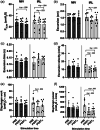Ultrasonographic evaluation of diaphragm fatigue in healthy humans
- PMID: 39780750
- PMCID: PMC11868021
- DOI: 10.1113/EP092322
Ultrasonographic evaluation of diaphragm fatigue in healthy humans
Abstract
Assessment of diaphragm function and fatigue typically relies on the measurement of transdiaphragmatic pressure (Pdi). Although Pdi serves as an index of diaphragm force output, it provides limited information regarding the ability of the muscle to shorten and generate power. We asked whether ultrasonography, combined with Pdi, could be used to quantify changes in diaphragm function attributable to fatigue. Eight healthy men [mean (SD) age, 23 (7) years] completed two tasks on separate occasions: (i) 2 min of maximal isocapnic ventilation (MIV); or (ii) 3 × 5 min of maximal inspiratory resistive loading (IRL). Diaphragm function was evaluated before (PRE) and after each task (POST1, 10-15 min and POST2, 30-35 min) using synchronous recordings of Pdi and subcostal ultrasound traces of the right crural hemidiaphragm during anterolateral magnetic stimulation of the phrenic nerves and progressive CO2 rebreathing. Fatigue was quantified as pre- to post-loading changes in twitch Pdi, excursion velocity (excursion/time) and power (Pdi × velocity). Both tasks resulted in significant reductions in twitch Pdi (P < 0.05). There were no effects of MIV on ultrasound-derived measures. In contrast, IRL elicited a significant reduction in twitch excursion at POST1 (-16%; P = 0.034) and significant reductions in excursion velocity at POST1 (-32%; P = 0.022) and POST2 (-28%; P = 0.013). These reductions in excursion velocity, alongside the concurrent reductions in twitch Pdi, resulted in significant reductions in diaphragm power at POST1 (-48%; P = 0.009) and POST2 (-42%; P = 0.008). Neither task significantly altered the contractile responses to CO2. In conclusion, subcostal ultrasonography coupled with phrenic nerve stimulation is a promising method for quantifying contractile fatigue of the human diaphragm.
Keywords: diaphragm; fatigue; ultrasound.
© 2024 The Author(s). Experimental Physiology published by John Wiley & Sons Ltd on behalf of The Physiological Society.
Conflict of interest statement
None declared.
Figures





Similar articles
-
Influence of inspiratory resistive loading on expiratory muscle fatigue in healthy humans.Exp Physiol. 2017 Sep 1;102(9):1221-1233. doi: 10.1113/EP086346. Epub 2017 Jul 22. Exp Physiol. 2017. PMID: 28646592
-
Diaphragm fatigue following maximal ventilation in man.Eur Respir J. 1996 Feb;9(2):241-7. doi: 10.1183/09031936.96.09020241. Eur Respir J. 1996. PMID: 8777959
-
Ultrafast ultrasound coupled with cervical magnetic stimulation for non-invasive and non-volitional assessment of diaphragm contractility.J Physiol. 2020 Dec;598(24):5627-5638. doi: 10.1113/JP280457. Epub 2020 Oct 20. J Physiol. 2020. PMID: 32997791
-
Paired phrenic nerve stimuli for the detection of diaphragm fatigue in humans.Eur Respir J. 1997 Aug;10(8):1859-64. doi: 10.1183/09031936.97.10081859. Eur Respir J. 1997. PMID: 9272931
-
Cervical magnetic stimulation: a new painless method for bilateral phrenic nerve stimulation in conscious humans.J Appl Physiol (1985). 1989 Oct;67(4):1311-8. doi: 10.1152/jappl.1989.67.4.1311. J Appl Physiol (1985). 1989. PMID: 2676953 Review.
Cited by
-
Diaphragm ultrasonography: A picture is worth a thousand words.Exp Physiol. 2025 Mar;110(3):358-359. doi: 10.1113/EP092452. Epub 2024 Dec 6. Exp Physiol. 2025. PMID: 39639854 Free PMC article. No abstract available.
References
-
- Aliverti, A. , Cala, S. J. , Duranti, R. , Ferrigno, G. , Kenyon, C. M. , Pedotti, A. , Scano, G. , Sliwinski, P. , Macklem, P. T. , & Yan, S. (1997). Human respiratory muscle actions and control during exercise. Journal of Applied Physiology, 83(4), 1256–1269. - PubMed
-
- Ameredes, B. T. , & Clanton, T. L. (1990). Increased fatigue of isovelocity vs. isometric contractions of canine diaphragm. Journal of Applied Physiology, 69(2), 740–746. - PubMed
-
- Ameredes, B. T. , Zhan, W.‐Z. , Prakash, Y. S. , Vandenboom, R. , & Sieck, G. C. (2000). Power fatigue of the rat diaphragm muscle. Journal of Applied Physiology, 89(6), 2215–2219. - PubMed
-
- Babcock, M. A. , Pegelow, D. F. , Johnson, B. D. , & Dempsey, J. A. (1996). Aerobic fitness effects on exercise‐induced low‐frequency diaphragm fatigue. Journal of Applied Physiology, 81(5), 2156–2164. - PubMed
-
- Baydur, A. , Behrakis, P. K. , Zin, W. A. , Jaeger, M. , & Milic‐Emili, J. (1982). A simple method for assessing the validity of the esophageal balloon technique. American Review of Respiratory Disease, 126, 788–791. - PubMed
MeSH terms
LinkOut - more resources
Full Text Sources
